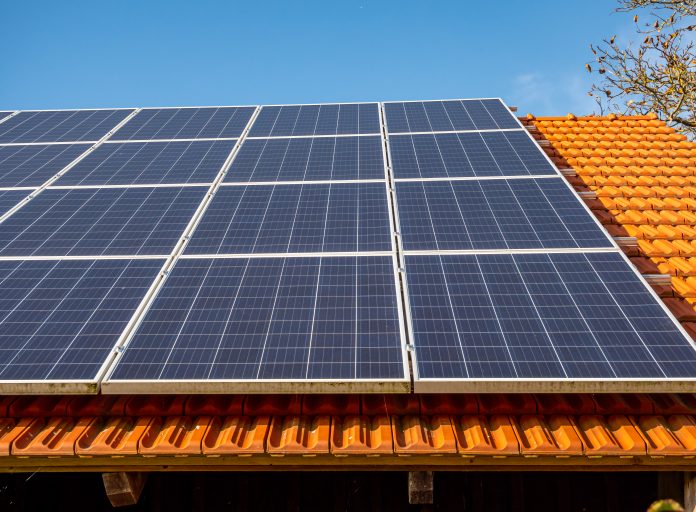Maiko Kiis, Marketing Manager at Solarstone finds out if solar roofs are worth the money and tells us what we need to know about building-integrated photovoltaics (BIPV)
Traditionally, going solar has meant installing a ground-mounted solar farm or panels on the top of roofs. Attaching a layer of PV panels on top of an existing roof with the purpose of going green lacks sense – up to 50% of excess materials are used on the roof, making the #gogreen into #greenwash. But roofs and solar panels can and should be the same thing in terms of resource efficiency.
Building-integrated photovoltaics (BIPV) are revolutionising how homeowners and businesses can incorporate solar energy production into their premises. BIPVs are multifunctional – generating renewable energy for your home while also being an integral and essential part of a permanent building structure. There are many building elements where BIPVs can be applied, such as roofs, facades, windows, skylights and balcony railings. The list doesn’t stop here. Let’s take a deeper dive into solar roofs.
Building-integrated solar roofs
The housing industry is open to new technologies and solutions that incorporate renewable energy production into building structures, especially rooftops. Solar panels can fit architecturally just right with the building. Solar roofs have gained popularity since 2016 and today there are tens or even hundreds of integrated solar panel and shingle producers all around the globe, all with their tweaks. Different types of solar roofing products are available and essentially they are all mini solar panels designed to look like and function as conventional roofing materials.
Why choose an integrated solar roof?
The major argument in favour of BIPVs is visual appeal, it just looks much nicer than regular panels. BIPV makes an architectural whole, whereas regular PV looks like a foreign body on your roof. If you have an existing house, installing regular panels may be more cost-effective, but for new-builds BIPV is more cost-effective. The difference comes from saving up on traditional roofing materials and reduced work-load. Regular solar panels can never be installed in heritage properties and protected areas, whereas BIPV may have that possibility. Producing solar energy and maximising self-consumption protects you from possible larger fluctuations in electricity prices for decades. Also, in the real estate market, energy-efficient buildings with building-integrated solar panels are significantly more attractive to buyers.
Although the benefits of integrated solar are apparent, 99% of rooftop solar installations today still take place with regular PV for two main reasons. One, BIPVs are more expensive and two, they tend to be over-engineered, which makes preparation and installation time-consuming and expensive.
“Solar roofs are designed to withstand rain, wind, and hail and should easily last for 25 years or more, just like all types of roofing alternatives.”
How long does a solar roof last?
Most solar shingles will last 25-30 years and maintain around 80% of the original output. Towards the end of their lifespan the efficiency drops, which is normal with all solar panels. Solar roofs are designed to withstand rain, wind, and hail and should easily last for 25 years or more, just like all types of roofing alternatives.
Maintenance of building-integrated solar roof
Solar panels are almost maintenance-free. There are no moving parts in the system that would need direct maintenance. In the spring, after the snow has melted and the plants and trees have been pollinated, dirt may cover the panels. It would be prudent to remove tree leaves and branches from the panels, which cannot be washed away by rain and hinder electricity generation potential. In areas with a lot of pollen and dust, the panels should be washed periodically. In general, it is enough to soak the panels with a hose from the ground, which removes the majority of dirt. Detergents are not necessary to clean the panels. Rain is generally the best cleaner.
Solar roof efficiency
The darker BIPV panels (e.g. solar shingles) have comparable efficiency ratings in contrast with regular solar panels. The roofs of private houses are generally large enough to bring the energy consumption of the house to near zero energy requirements (in the case of new houses) or to raise the energy label of an existing house.
In Northern Europe, for example, stationary installations facing directly south and with a slope of 35-45° are the most efficient. The east-west PV plant loses up to 20% in productivity but covers more of the daily consumption (production also in the morning and evening, not during the day only). The productivity of PV plants with lower slopes (including integrated roof solutions) is also up to 20% lower, and in addition, such solutions are not favoured by roof tile manufacturers (installations below 18° require 100% watertight underlay). Shadows that fall periodically from trees or surrounding buildings are not a barrier to solar plant installation, but should preferably be avoided. Shadows, incorrect weather arc and roof pitch can significantly impair the potential of the solar panels.
Going off-grid with a solar roof
Most installations are connected to the grid, which doesn’t protect you from outages but does provide convenience. In some countries, unused solar energy can be sold back to the grid, whereas in others, you’ll get credit for it, reducing electricity bills in the winter. While energy storage systems are still some time away from reaching the masses due to high prices, they will most definitely make their way into homes in the near future. There are a rising number of solar roof installations for off-grid houses and cabins already today, but we’d have to consider that a niche. The sad reality is that in a lot of countries going off-grid without a generator is not possible – there’s just not enough sun irradiation during some seasons.
Is a solar roof worth it?
The economic factor of solar roofs is that they serve a double function. They are especially beneficial for homeowners who need a new roof and want to retain aesthetics and roof functionality. In many countries, there are still subsidies for local renewable energy production, which makes solar even more attractive. A solar roof can potentially cut the electricity bill of an efficient home down to near zero. Despite the high initial investment, solar roofs tend to be worth it. If you’re looking for a way to save the most on your electric bills, you’re probably better off going with a traditional solar panel installation. Bear in mind that a traditional roof does not bring your electricity costs down, nor earn the investment back.











